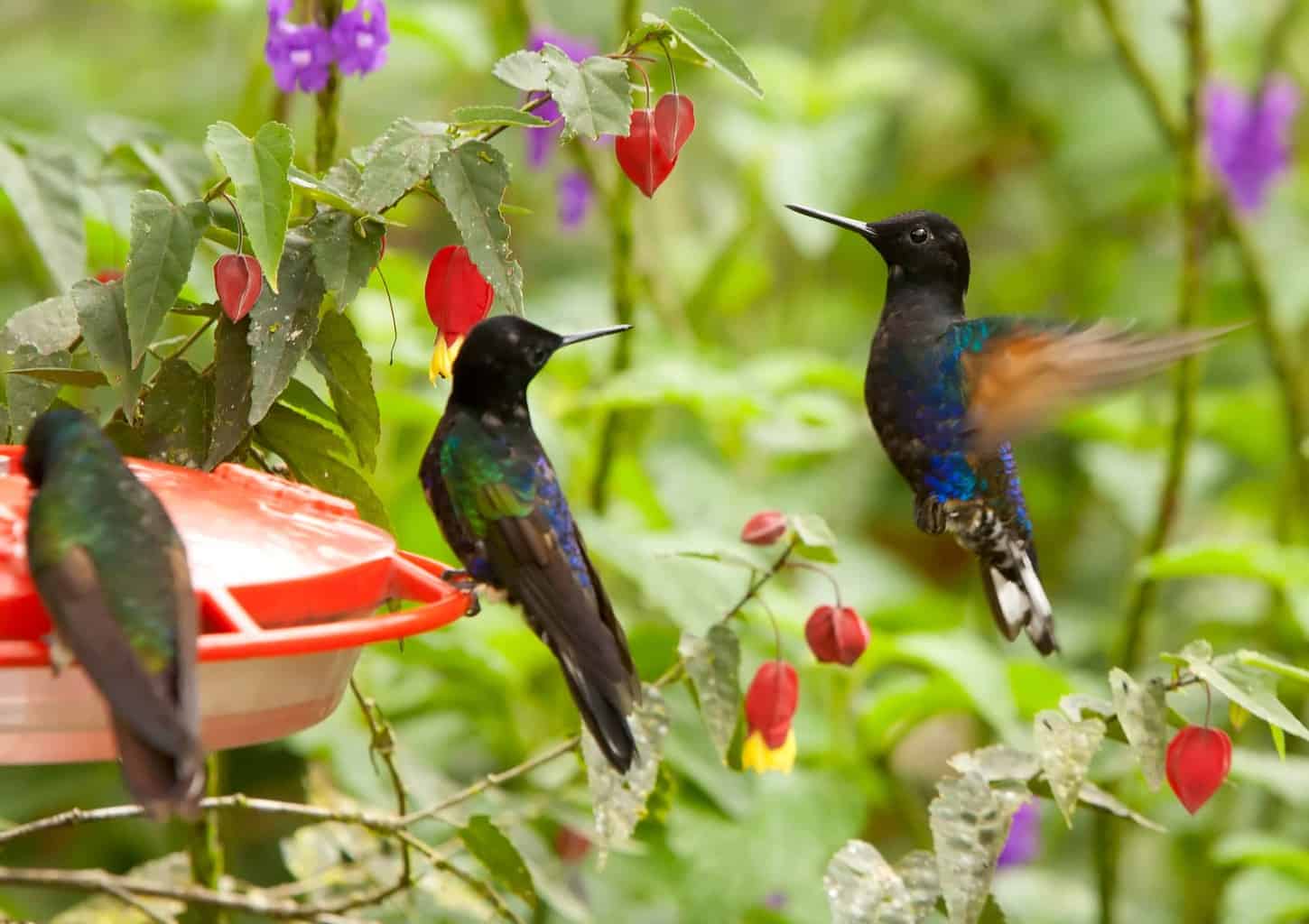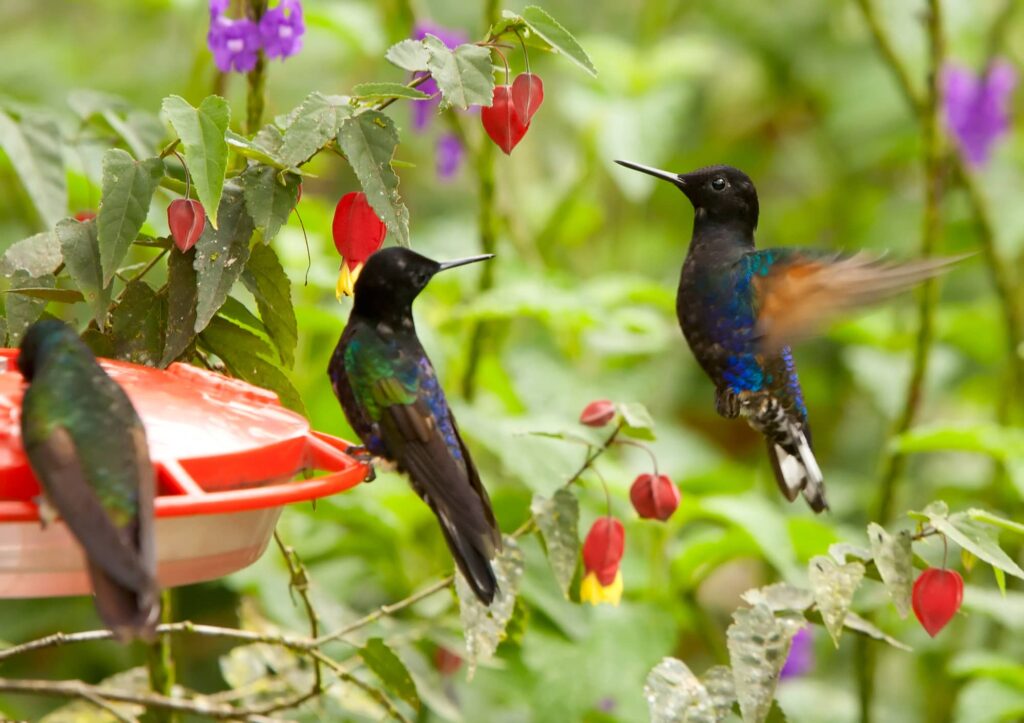Alaska’s wild expanses of wilderness offer something special to nature lovers. Whether you are visiting or live in the state, the hummingbird migration is one of many amazing wildlife spectacles to enjoy.
Rufous hummingbirds are the most common hummingbird seen in Alaska. They typically arrive in March and April, breed and nest in parts of the state, and depart between July and mid-August.
Hummingbirds’ long migration is always a wonder – but more so here than in the lower 48. Rufous hummingbirds are tiny birds, just three inches long. Yet to reach Alaska, they will have flown 2,000 miles or more over mountainous and rugged terrain.
One record-breaking bird is even known to have flown 3,500 miles – the longest migration of a hummingbird ever recorded. It flew from Tallahassee, Florida, to Chenega Bay in five months.
No wonder local indigenous people have said that these tiny birds migrate on the backs of geese – their explanation for this remarkable feat.
What Hummingbirds are Seen in Alaska?
Three different hummingbird species migrate to Alaska: the Rufous hummingbird, Costa’s hummingbird, and Anna’s hummingbird.
Only the first of these is common. The Rufous hummingbird is the most widespread hummingbird species in the United States. The northern Gulf of Alaska and Prince William Sound lie at the very northern extent of its breeding range.
Costa’s hummingbirds and Anna’s hummingbirds are considered casual migrants to the southeast and south-central portions of the state and are not seen nearly so frequently.
Where in Alaska Can Hummingbirds Be Seen?
The Chugach and Tongass National Forests support the majority of breeding habitats for Rufous hummingbirds in Alaska. Hummingbirds’ use of the northwestern interior forest region has also been documented. Mostly, however, hummingbirds are seen within five key ecoregions in Alaska:
- Cook Inlet Basin
- Boundary Ranges
- Alexander Archipelago
- Gulf of Alaska Coast
- & Chugach-St Elias Mountains
If you live within one of these ecoregions around the Gulf of Alaska, you may well spot hummingbirds in your area and be able to welcome them onto your property.
Unfortunately, if you live elsewhere in Alaska, you will have to travel to this area to see hummingbirds in your state.
When Do Hummingbirds Arrive in Alaska?
Male Rufous hummingbirds arrive in Alaska around March. They make their way northward, spreading along the coast through the Gulf of Alaska region and reaching Chenega Bay and the area around Prince William Sound ( the north of their range) by around the last week in April.
A week or two later, the females will arrive to breed and nest until June. You might not see the birds as much for a few weeks until the fledglings appear in July.
The precise timing of the spring migration can vary. It will alter slightly depending on the weather conditions and food availability in a given year.
You should also remember that hummingbirds take individual migration routes rather than traveling in groups together, and not all will arrive at once.
However, generally speaking, you can expect the birds to arrive in Alaska within the same rough period each year.
What Route Do Hummingbirds Take to Alaska?
Interestingly, little is known about the route the hummingbirds take to reach Alaska. However, it is suggested that they leave their wintering grounds, head west to the Pacific coast, and follow the coast north. They may follow an elliptical migration route.
Knowledge of these birds’ migration path is gradually being added to by monitoring and banding networks and groups working on hummingbird conservation across the US.

Preparing for the Arrival of Hummingbirds in Alaska
Hummingbird numbers are declining. But if you live in Alaska, you can play a role in helping to protect this crucial pollinating species.
The best way to provide hummingbirds with what they need is to create planting schemes on your property to provide them with the nectar, other forage resources, and insects that they eat. However, placing feeders can also help to ensure that they have all they need after their long migration.
How to Attract Hummingbirds to Your Alaska Property
You can plant native species on your property that are particularly beneficial to visiting and potentially breeding and nursing hummingbirds in your area.
Some native plants for all the ecoregions visited by hummingbirds include:
- Alder
- Angelica
- Devil’s club
- Early blueberry
- Fireweed
- Nootka lupine
- Partridgefoot
- Red elderberry
- Rusty mensiesia
- Western columbine
- Willows
- Unalaska paintbrush
These plants are considered to be particularly beneficial for hummingbirds. But of course, these are just a small number of the many native plants that aid hummingbirds and other wildlife in the region.
Hummingbirds get the water they need from the nectar and insects they consume. But they are drawn to running water and spend time in riparian and wetland environments.
So adding a water feature and creating wildlife ponds, wetlands, and other such elements in your garden or on your Alaska property can help create the perfect habitat for these birds.
When Should I Put Out Hummingbird Feeders in Alaska?
You should aim to put out your hummingbird feeders a week or two before you expect the first hummingbirds to arrive so that you can cater to early migrators. In the south, this might be in early March or a little later if you live at the very northern extent of their range.
When Do Hummingbirds Leave Alaska?
Male Rufous hummingbirds will begin to leave Alaska soon after their young have fledged. The females will remain with their young until around the first week in August when they will also depart the northern Gulf of Alaska coast.
A little further south, the birds may linger just a little longer, but most will have departed the state before the middle of the month.
These hummingbirds will make their way back south when they leave Alaska. Usually, they are found wintering in Mexico and across the southern US.
When Should I Take Down Hummingbird Feeders in Alaska?
Hummingbird feeders should always be left in place until you have no longer seen any hummingbirds in your garden for a couple of weeks. This will ensure that late migrators get the boost they need to make the long journey south.
Some people think that leaving hummingbird feeders out too long will stop the birds from making the migration south. But this is not the case.
Hummingbirds will migrate south even when there are abundant food sources available. So, leaving out feeders won’t prevent them from making the trip.
However, a few individuals may be too old or infirm to migrate. If you still see individuals on your property after the majority have left, continuing to feed them, if possible, is the kind thing to do.
After such a long journey to Alaska (and not on the back of a goose), hummingbirds that have made it to Alaska certainly deserve our respect and warm welcome.
So if you live in the state, you should do all you can to provide them with what they need. Plant and prepare to give them all they need to recover from the long journey north, spend a pleasant summer in the state, and build strength for the long return journey to the south.

